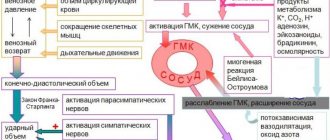Types of vegetative-vascular dystonia (VSD)
Depending on how the cardiovascular system reacts to a disorder of the autonomic nervous system, 4 types of VSD are conventionally distinguished: hypertensive, hypotonic, cardiac and mixed. A more detailed study of the signs of vegetative-vascular dystonia made it possible to identify 3 more types of disorder: vagotonia, cerebral-type VSD and somatoform dysfunction.
This typology is outdated, however, it allows you to classify all symptoms of VSD. The problem of diagnosing autonomic dysfunction is acute, and patients often become victims of ignorance or inattention of doctors. Let's figure out what symptoms may indicate the presence of one or another form of autonomic dysfunction.
VSD of cardiac type
In the cardiological (as well as in the hypertensive) form of autonomic dysfunction, the diagnosis will most likely show obvious sympathicotonia, that is, functional tension in the work of the sympathetic department of the ANS. A distinctive feature of VSD of the cardiac type is pain in the heart area (stabbing, pressing or burning sensations in the chest area). Signs may resemble those of an angina attack or myocardial infarction. But upon examination, cardiac pathologies are not detected.
The cardiac type of reaction to a vegetative-vascular disorder is characterized by: tachycardia, cardiac arrhythmia, false pain in the heart area, as well as respiratory arrhythmia and asthma attacks. It is important to understand that with VSD, pain in the heart area is not a harbinger of a heart attack and does not in any way affect the cardiovascular system, which will be confirmed by the patient’s echocardiogram. Cardiac rhythmography is very effective in diagnosing this type of VSD.
Symptoms of vascular disorders in VSD
Under the influence of external and internal stimuli, blood vessels change their tone, which is how the body regulates blood flow to organs and tissues.
This is a normal reaction that helps a person adapt to different conditions and stay healthy. But with autonomic dysfunction (VSD), the reaction of blood vessels is often inadequate: they expand and contract without physiological need, or in spite of it. Redness or paleness of the skin, dizziness or pulsation in the temples, coldness of the hands and feet, hot flashes or chills - these are the symptoms of abnormal vascular response that can be noticed with VSD. There are also those that remain unnoticed, but are reflected in the functioning of internal organs.
Inadequate blood circulation can manifest itself as abdominal cramps, slower secretion of digestive juices, and muscle cramps. But all these symptoms may also be present in other disorders not related to vegetative-vascular dystonia.
VSD of mixed type
Depending on how the cardiovascular system reacts to a disorder of the autonomic nervous system, the 3 types of VSD described above are conventionally distinguished. But, as a rule, vegetative-vascular dystonia includes several types of symptoms at once.
The mixed type is characterized by a combination of the above symptoms. Blood pressure “jumps”, a person feels sometimes depressed, sometimes irritated, sometimes experiences weakness, sometimes excessive emotional overexcitation, and his mood changes sharply. With a mixed type of VSD, the whole spectrum of symptoms can manifest itself: cardiac and respiratory arrhythmia, panic attacks, pain with vague localization. This type of autonomic disorder is the most common.
VSD of vagotonic type
Vagotonia is characterized by a wide variety of symptoms, which can raise suspicion of serious diseases of the heart, endocrine or respiratory system, diseases of the gastrointestinal tract or even the psyche. A thorough examination does not reveal any pathologies in the organs and systems of the body. And as a “diagnosis of exclusion,” the patient is diagnosed with “VVD of the vagotonic type.” Indeed, a variety of symptoms that do not fit into a single pathological process are caused by vagotonia - hypertonicity of the vagus nerve (“vagus”). The vagus nerve regulates the activity of organs, glands and blood vessels, and an increase in its tone causes spasm of smooth muscles throughout all structures of the body.
With this type of VSD, the activity of the parasympathetic part of the nervous system predominates (over the sympathetic), which will be confirmed by the diagnosis of CRH. A person becomes apathetic, unsure of himself, suspicious, suffers from hypochondria, suspecting that he has the most terrible and, perhaps, still unknown disease. Memory for specific things often deteriorates: numbers, dates, details, and mental activity decreases.
Physical symptoms are bradycardia, hypotension, vestibular disorders (dizziness and fainting), fatigue, shortness of breath, pale skin, cold extremities, non-localized pain in the abdomen and chest. Despite the broken state, the person experiences difficulty falling asleep and does not sleep well during the night. In advanced cases, patients experience panic attacks, depression and suicidal tendencies. Symptoms can appear in a complex manner, or they can be localized - when complaints are limited to one of the organ systems. The disease can be chronic or manifest itself in the form of outbreaks, vegetative crises, when the condition sharply worsens. In vagotonic children, the pathology also manifests itself in an abundance of allergic reactions.
Vegetative-vascular dystonia: “mysteries” of diagnosis
Over the years, attitudes towards the diagnosis of VSD have changed both among doctors and patients. Together with a neurologist of the highest category, candidate of medical sciences, head of the consultative and diagnostic department of the clinic of the Federal State Budgetary Institution "Research Institute of Therapy and Preventive Medicine" SB RAS Svetlana Duma, we decided to debunk the myths with which this disease is associated today.
Vegetative-vascular dystonia is indeed a fairly new phenomenon. Knowledge of the autonomic nervous system was first developed only in the twentieth century by academician Alexander Wein. However, today 80% of patients who consult a neurologist have a disorder that doctors characterize as vegetative-vascular dystonia. At the same time, the number of such patients is growing rapidly, and antidepressants, which are used to treat VSD, have long taken first place among the best-selling medications. During the short history of its existence, a clear understanding of this disease has not emerged among patients.
Myth 1.
VSD is a vascular disorder.
In fact
This is an imbalance of all organs and systems for the coordination of which the autonomic nervous system is responsible.
According to the definition of Alexander Wein, VSD is a violation of various functions of the body, usually somatic, that is, physically tangible. The cause of these disorders is a failure in the nervous regulation carried out by the autonomic nervous system. It is she who is responsible for synchronizing the processes occurring in the internal organs.
Myth 2.
The cause of VSD is a chronic disease.In fact
Chronic disease can trigger VSD in older people, but in most cases the cause of VSD is a nervous disorder.
Another exception is adolescents whose hormonal levels change during puberty, as well as people with endocrine pathologies. And yet, according to neurologists, only 20% of patients with vegetative-vascular dystonia have a primary pathology of any organ or system.
“In middle-aged and older people, indeed, VSD can develop against the background of some kind of somatic disease
, says Svetlana Duma.
– This could be pathology of the gastrointestinal tract, vascular diseases of the heart or brain, neurodegenerative diseases, consequences of injuries and infections.
But if we talk about the most common cause of VSD, then these are neurotic disorders - anxiety or anxiety combined with depression.” One of the most complex manifestations of VSD, which has developed on a nervous basis, is panic attacks, that is, sudden inexplicable attacks of fear, accompanied by bodily discomfort. As a rule, these symptoms occur when the patient delays treatment of the pathology without recognizing its psychological, or rather psychiatric, nature.
Myth 3.
There is no diagnosis of VSD.In fact
There is such a diagnosis in disease classifiers, but it is not in its “right” place, hence its “non-existence”: the diagnosis is indeed not somatic, but it is not officially classified as a nervous disease.
Since the true cause of most cases of VSD is a disorder of a nervous nature, in the classification of diseases it, logically, should belong to the section of nervous diseases.
However, due to established practice, the diagnosis of VSD is located among somatic (bodily) diseases. According to doctors, the reason for this discrepancy is that patients with vegetative-vascular dystonia are in no hurry to turn to psychiatric specialists.
“If we exclude an organic cause, we diagnose VSD on the background of an anxiety disorder, although the anxiety disorder comes first here
, says Svetlana Duma.
– If such a patient gets to a psychiatrist or psychotherapist, he will be given, in fact, the correct diagnosis. This will be, for example, a somatoform or anxiety disorder, due to which VSD syndrome develops. This bureaucratic discrepancy is apparently due to the fact that people do not want to go to the right doctor.”
Myth 4.
A doctor may miss a serious disease by diagnosing VSD.In fact
The patient is always carefully examined, even if he is “recognized” as a patient with VSD.
The diagnosis of VSD is made by exclusion. This means that when examining a patient with suspected vegetative-vascular dystonia, all possible somatic pathologies are excluded.
“Experienced neurologists immediately see a patient with VSD, but they cannot take upon themselves the responsibility of diagnosing him without additional examinations,
– explains the doctor.
– We look at the probable objective cause that is causing the problem, and if we do not confirm it, we make a diagnosis of “VSD.”
The patient's examinations include a health check according to a certain standard, which includes an ECG and a blood test. In addition, the patient’s endocrine system is checked - the condition of the thyroid gland, pituitary gland, hypothalamus and adrenal glands.
Myth 5.
VSD is the second name for another disease.In fact
Other names for VSD are related to the fact that at one time they tried to rename this diagnosis, but now it has no official synonyms.
“We have a variant of the diagnosis that, in general, has become obsolete - neurocirculatory dystonia
, says Svetlana Duma.
– It implies slight fluctuations in pressure, minor rhythm disturbances. Now this diagnosis is not made; instead, VSD is given. They tried to rename VSD, for example, there was a syndrome of vegetative dystonia, Alexander Moiseevich Vein proposed “psycho-vegetative syndrome.” The name may vary, but the classification remains “VSD”.
Myth 6.
Symptoms of VSD are concentrated in the head area.In fact
Symptoms can manifest themselves both from the gastrointestinal tract and as pain in the chest.
Neurologists call VSD a multisystem diagnosis: the disorder attacks the patient from an unexpected direction, and sometimes from several sides at once. A patient with VSD may complain, for example, of pain in the heart area, but when questioning the doctor, it turns out that he has been tormented by intestinal problems for a long time, chills appear inappropriately, and sometimes his body temperature fluctuates.
“Very often, patients with VSD complain of pain, from different sides. One of the variants of autonomic dysregulation is functional disorders of the gastrointestinal tract,
— says Svetlana Duma.
– In recent years, they have been encountered so often that gastroenterologists have identified them as a separate category. In the 19th century, these disorders were called intestinal neurosis; now they are functional disorders of the gastrointestinal tract.”
Myth 7.
VSD is a congenital pathology, and at the same time “lifelong”.In fact
VSD is usually acquired in a stressful situation, and it is possible to get rid of dystonia with proper treatment.
According to the doctor, the success of treatment depends on individual “brain chemistry.” As a rule, treatment is quite long, but it does not last for the rest of your life. At the same time, the disease can catch a person, as they say, out of the blue, because almost everyone is exposed to stress today. But it is a stressful situation that often becomes a trigger for symptoms of VSD.
“In the 90s in Novosibirsk there were small echoes of the earthquake, to which many residents reacted with fear and deterioration in health,
- the doctor recalls.
– Then a whole layer of so-called vegetatives went to neurologists.
Sometimes in a stressful situation a person mobilizes and copes with the problem, sometimes very successfully. Often after such situations an anxiety disorder occurs because the body is overstressed and is unable to relax.” How to treat?
Unfortunately, a patient with VSD due to a nervous disorder today is in a difficult situation. On the one hand, he should contact a psychiatrist, but specialists in mental illness, as a rule, do not find sufficient grounds for treatment. The services of their alternative, psychotherapists, are usually not cheap. However, in not very advanced cases, patients with a disorder of the autonomic system can be helped by a neurologist or therapist. According to the doctor, it is they who see the vast majority of such patients.
“In Soviet times, therapists were turned into psychotherapists, but now, of course, there is no such thing,
– says Svetlana Duma.
“ But today a therapist can prescribe first-line antidepressants, which are allowed for everyone.
In this case, it is the nervous disease that needs to be treated – anxiety or anxiety-depressive disorder. We can prescribe mild medications that stabilize autonomic activity, but if the nervous disorder is not treated, after some time all the symptoms will return.”
Prevention of vegetative-vascular dystonia
But prevention of nervous VSD is simple. If it is hardly possible to protect yourself from stress in modern conditions, then everyone can prevent nervous overexertion, the doctor assures. To do this, you just need to set aside some time for rest every day and during the week.
“The body is like a spring; if you constantly strain it, it will react in the form of imbalance,” says Svetlana Duma. – It is also important to learn to enjoy the little things. If a person knows how to have fun every day, that’s great – it improves his health.”
Related articles:
Under the pressure of depression
Panic attacks: silent horror
VSD of cerebral type
With vegetative-vascular dystonia of the cerebral type, the tone of the blood vessels in the brain is disturbed. The blood vessels spasm, which leads to disruption of blood supply and nutrition to the brain. Cells lack oxygen, and blood flow deteriorates.
The primary symptoms are headaches, dizziness, blurred vision, noise and pounding in the ears, and nausea. Other symptoms of VSD may also appear: pain in the heart, tachycardia, vascular instability (bouts of heat, sweating, pale skin), difficulty breathing, shortness of breath and a number of other symptoms. According to cardiac rhythmography data, VSD of the cerebral type will be expressed by hyperactivity of waves from the autonomic centers of the brain and, possibly, sympathetic waves.
Clinical types of the syndrome
Posterior cervical sympathetic syndrome (Barre–Lieu)
Posterior cervical syndrome is characterized by headaches localized in the cervical-occipital region with radiation to the front of the head. The headache is usually constant, often in the morning, especially after sleeping on an uncomfortable pillow. Headache may occur when walking, driving a car, or when moving the neck. The headache can also be pulsating, piercing, localized in the cervical-occipital region and radiating to the parietal frontal and temporal zones. Headache may intensify when turning the head and is accompanied by vestibular, visual and autonomic disorders.
Migraine basilar
Basilar migraine does not result from compression of the vertebral artery, but from stenosis of the vertebral artery, but clinically has much in common with other forms of vertebral artery syndrome. As a rule, a migraine attack begins with a sharp headache in the back of the head, vomiting, and sometimes loss of consciousness. Visual disturbances, dizziness, dysarthria, and ataxia are also possible.
Vestibulo-cochlear syndrome
Disturbances from the hearing system manifest themselves in the form of noise in the head, decreased perception of whispered speech and are recorded by changes in data during audiometry. Tinnitus is persistent and long-lasting and tends to change when the head moves. Cochlear disorders are associated with dizziness (both systemic and non-systemic).
Ophthalmic syndrome
With ophthalmic syndrome in the foreground, visual disturbances such as scintillating scotoma, decreased vision, photopsia may also be symptoms of conjunctivitis (lacrimation, conjunctival hyperemia). Loss of visual fields can be episodic and is mainly associated with changes in head position.
Autonomic change syndrome
As a rule, autonomic disorders do not appear in isolation, but are combined with one of the syndromes. Autonomic symptoms are usually the following: a feeling of heat, a feeling of cold extremities, sweating, changes in skin dermographism, sleep disturbances.
Transient ischemic attacks
Ischemic attacks can occur during the ischemic stage of vertebral artery syndrome. The most common symptoms of such attacks are: transient motor and sensory disturbances, visual disturbances, hemianopsia, ataxia, attacks of dizziness, nausea, vomiting, speech impairment, swallowing, double vision.
Syncopal vertebral syndrome (Unterharnscheit syndrome)
An episode of syncopal vertebral syndrome is an acute circulatory disorder in the area of the reticular formation of the brain. This episode is characterized by a short-term loss of consciousness when turning the head suddenly.
Drop attack episodes
An episode of a drop attack (fall) is caused by impaired blood circulation in the caudal parts of the brainstem and cerebellum and will clinically manifest itself as tetraplegia when the head is thrown back. Restoration of motor functions is quite rapid.
Somatoform dysfunction
With somatoform dysfunction, a person usually complains about a specific organ or group of organs that are regulated by the autonomic nervous system. These may be complaints about the cardiovascular, gastrointestinal, respiratory or genitourinary systems. The patient associates his condition with a physical disorder, but based on the results of the examination, the doctor finds no reason for it. The true cause of the malaise is a disruption in the functioning of the autonomic nerve centers. In addition to subjective localized pain, heaviness, burning or tension, specific symptoms of VSD can be easily identified among the patient’s complaints.
The variety of symptoms of autonomic dysfunction makes it difficult for the doctor to get to the root cause of the disease. Therefore, in addition to collecting anamnesis, it is important to conduct instrumental studies of the functioning of the autonomic nervous system. Find out more about diagnosing autonomic disorders.







